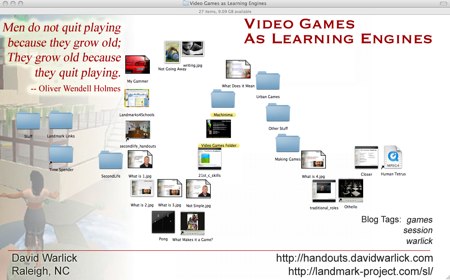Geek Warning: This is probably about a 7.5 on the 10 point geek scale!
I wrote a while back about how impressed I was with Stephen Heppell’s method for doing keynotes. Rather than using Powerpoint slides, he presents right out of his hard drive, concepts organized by folders (see Stephen Heppell Keynote at SuperConference and Tinker Toy Networks). I’ve played around with it myself, working with some of the techniques that he taught me, and I like it. Just before starting my video games sessions yesterday,  a teacher came up to me and asked some important questions about SecondLife. I’d not planned to go into so much detail about the virtual world, but they were such good questions, that I quickly, in about a half minute, made a new folder, and dumped some images, a video, and several web links into the folder. It seems to be a very brain-like way to teach.
a teacher came up to me and asked some important questions about SecondLife. I’d not planned to go into so much detail about the virtual world, but they were such good questions, that I quickly, in about a half minute, made a new folder, and dumped some images, a video, and several web links into the folder. It seems to be a very brain-like way to teach.
My nagging question has been, what to leave with the audience. With Powerpoint and Keynote, I can post the slides on Slideshare. No easy way to do this from my hard drive. I tried just building an outline on my online handouts, but that was time-consuming and editing it each time I added or deleted something is problematic.
Then I tried using Inspiration to create a graphical, branching tree type approach, and this looked great. However, when it came time to edit it, I had to edit the Inspiration file, export it as HTML, upload, etc. Looked great, but it was contrary to the spirit of having an easily adaptive technique of presenting content. I also tried a couple of online idea mapping tools, and like Mind42 a lot. However, they just upgraded the software and there are still some bugs. I’ll probably go back to them when they’ve fixed the publish feature.
But in the process of playing around with Mind42, I learned about FreeMind. It’s an open source downloaded (Windows, Mac OSX, & Linux) application that is designed for free form idea and project tracking. It is fairly customizable using CSS and the files can be exported as MM format, which seems to be a standard idea mapping file format. Mind42 imports them, so that’s what I’ll be trying next.
 But what really works for me is that FreeMind will import file structures. I simply find the folder for my presentation, import it, and FreeMind creates a branching graph that reflects the file and folder structure. It even hyperlinks any web shortcuts that I’ve included. There is some cleanup necessary, as it captures invisible files as well. So you have to delete those out, and do a little rearranging, which is very easy, once you learn the keyboard shortcuts.
But what really works for me is that FreeMind will import file structures. I simply find the folder for my presentation, import it, and FreeMind creates a branching graph that reflects the file and folder structure. It even hyperlinks any web shortcuts that I’ve included. There is some cleanup necessary, as it captures invisible files as well. So you have to delete those out, and do a little rearranging, which is very easy, once you learn the keyboard shortcuts.
FreeMind will then export as an XHTML file with a clickable map that links to an outline, also generated by the program. The only step left is FTP’ing the file up to my web server, for which I’ve started using the Fireftp Firefox extension, so I don’t even have to launch a FTP client.
Here is the end product.
I’m fairly happy with this.

First, let me say thanks for the great seminars this past week in North Dakota. I attended your RSS and Wiki sessions–both excellent.
I liked your presentation style, using desktop folders instead of a PowerPoint presentation.
I tried FreeMind. It downloaded quickly and was pretty straightforward. I started with File->New and then File->Import->File Structure. Worked like a charm and all the links came through.
It just hit me that this would be a nice way to do a “site map” for a website: in about two minutes you’d have an elegant and complete page.
PS: I experimented with my “WINDOWS” file folder first and it was a bad idea–waaaaay too many files and I had to restart the program. Don’t do it.
You could always use Screencast-O-Matic to record your presentation. It would play more like a movie than a slide show but people would also get your narration in addition to being able to view your folders. Heck, you could use this for each presentation, then at the end of the presentation save the recording and tell people if they want to watch your presentation again or share it they can do so at your website. These screen casts are also fully embedable and can be downloaded. I have been playing around with this service for a few months now and can say it is one of my favorite new web2.0 tools.
Great post. Thanks for all the detail. I’m going to have to try out FreeMind.